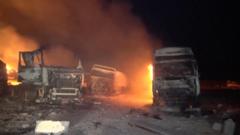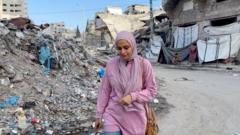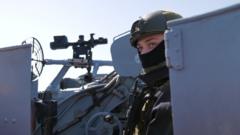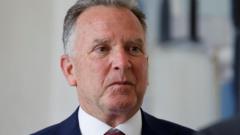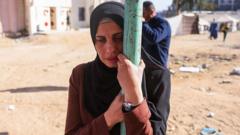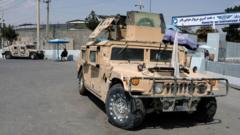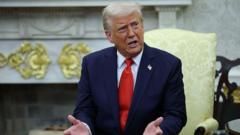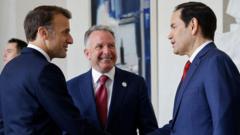As Iran and the United States gear up for their second round of high-stakes nuclear talks in Rome, excitement about a potential de-escalation is dampened by escalating military threats and a series of mixed messages. US President Donald Trump has reiterated his hardline stance, emphasizing that Iran must choose between a deal or military confrontation. He notably indicated that Israel would lead a military strike if discussions falter, but tempered his rhetoric by stating he prefers diplomacy over intervention.
High-Stakes Nuclear Talks: Mixed Signals and Military Threats Loom Over Iran and US Relations

High-Stakes Nuclear Talks: Mixed Signals and Military Threats Loom Over Iran and US Relations
Anticipation grows as Iran and the US prepare for crucial nuclear negotiations amid rising tensions and military posturing.
While both sides had described their initial discussions in Oman as productive, Trump indicated his decision on Iran policy would come swiftly. In 2018, he exited a landmark agreement designed to limit Iran’s nuclear activities, enforcing stringent sanctions that led to Iran's increased nuclear activities as a form of retaliation. Despite stockpiling sufficient enriched uranium for potential weapons production, Iran maintains it has no intentions of pursuing nuclear arms.
Compounding the complexity of negotiations, mixed signals have emerged from both sides regarding Iran's nuclear enrichment. US Special Envoy to the Middle East Steve Witkoff asserted that any deal must prioritize the elimination of Iran’s enrichment capabilities, but soon suggested that Iran could continue limited uranium enrichment under certain conditions. Iranian Foreign Minister Abbas Araghchi highlighted these contradictions and reaffirmed Iran’s commitment to its enrichment program as a non-negotiable issue.
Diplomatic maneuvers continue with Saudi Arabia's Defense Minister engaging Tehran, alongside Iranian officials bolstering ties with Russia amidst the ongoing conflict in Ukraine. Concurrently, IAEA chief Rafael Grossi's mission aims to restore oversight and mitigate tensions.
Despite a cautious optimism from both sides following the initial talks, deep-rooted distrust remains a barrier, particularly in light of past US actions. Trump's withdrawal from prior agreements and aggressive policies have fostered skepticism within Iranian leadership. As negotiations unfold, both nations grapple not just with military risks but also domestic pressures stemming from economic hardships and the potential for public dissent.
With contrasting narratives about the nature of the discussions—direct from the US perspective versus indirect from Iran—the talks remain shrouded in uncertainty. As officials navigate this intricate landscape, the stakes are unmistakably high—both in terms of international diplomacy and internal stability for the Iranian regime.
Compounding the complexity of negotiations, mixed signals have emerged from both sides regarding Iran's nuclear enrichment. US Special Envoy to the Middle East Steve Witkoff asserted that any deal must prioritize the elimination of Iran’s enrichment capabilities, but soon suggested that Iran could continue limited uranium enrichment under certain conditions. Iranian Foreign Minister Abbas Araghchi highlighted these contradictions and reaffirmed Iran’s commitment to its enrichment program as a non-negotiable issue.
Diplomatic maneuvers continue with Saudi Arabia's Defense Minister engaging Tehran, alongside Iranian officials bolstering ties with Russia amidst the ongoing conflict in Ukraine. Concurrently, IAEA chief Rafael Grossi's mission aims to restore oversight and mitigate tensions.
Despite a cautious optimism from both sides following the initial talks, deep-rooted distrust remains a barrier, particularly in light of past US actions. Trump's withdrawal from prior agreements and aggressive policies have fostered skepticism within Iranian leadership. As negotiations unfold, both nations grapple not just with military risks but also domestic pressures stemming from economic hardships and the potential for public dissent.
With contrasting narratives about the nature of the discussions—direct from the US perspective versus indirect from Iran—the talks remain shrouded in uncertainty. As officials navigate this intricate landscape, the stakes are unmistakably high—both in terms of international diplomacy and internal stability for the Iranian regime.


